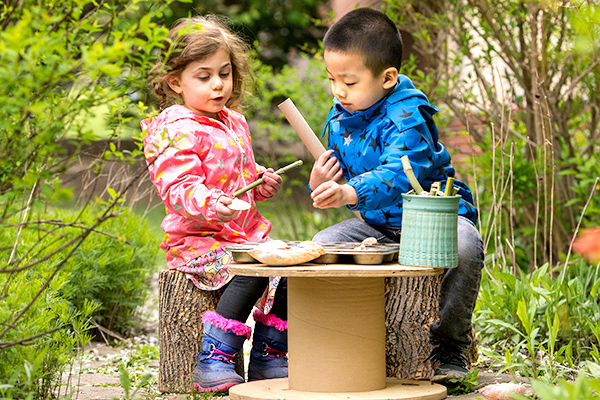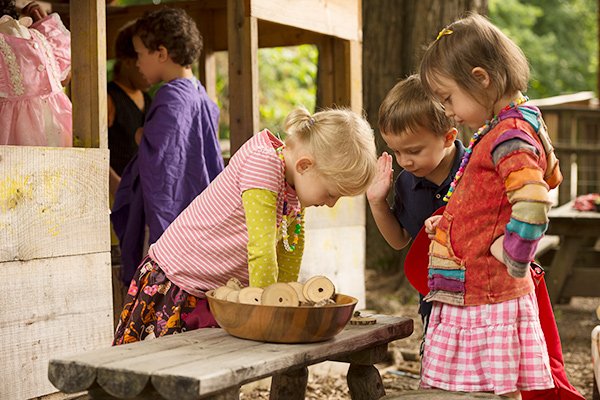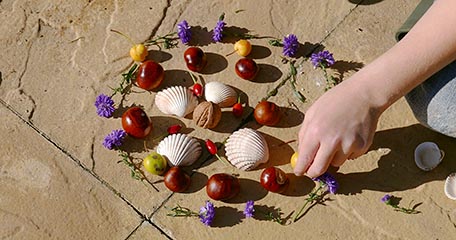Developing children's mathematical learning outdoors
| October 2018When I am invited into early years’ settings and in the primary school to model what I consider to be effective practice in supporting and enhancing children’s mathematical learning, I am very conscious that the focus has to be on taking the children’s learning forward. It is not uncommon for me, in a nursery setting, to start “playing” with a resource I have brought in and to “think aloud” in the hope that a child will come over and ask what I am doing and decide to join in. Some look, some return and some don’t visit the experience at all, but many children observe to see whether you are a playful person. Children are highly astute as to the value you give to play and whether it is a serious thing to do. I have often said that to be accepted into a child’s play or for children to want to join in and to see you as a co-player is a privilege. It is not uncommon for children to demonstrate attitudes to learning, ways of learning and knowledge of maths through more active or play-based pedagogy in the early (and later) stages of school in a way that may not have been seen in other ways of teaching and learning methodology. The term “active learning” is not about children running around noisily with lots of resources everywhere. The focus has to be on the deep level of engagement which, given the right circumstances, takes children to a different level in their thinking and motivation for maths.
The value of the quality of interaction, alongside meaningful contexts for learning, is one which has to be shared with parents and carers. We need to consider the family learning opportunities for that extended shared understanding of how young children learn about maths so that they, in turn, can support their own everyday experiences in the home and wider environment.
The Researching Effective Pedagogy in the Early Years (REPEY) study highlighted the importance of sustained shared thinking as a key indicator of quality settings (Siraj-Blatchford et al., 2002). The value of the key ways in which staff can support children through effective questioning was explored, and the definition of “sustained shared thinking” was given as:
… an episode in which two or more individuals “work together” in an intellectual way to solve a problem, clarify a concept, evaluate activities, extend a narrative, etc. Both parties must contribute to the thinking and it must develop and extend.

Mathematical language is often thought of simply as terminology, as described in Chapter 3, where the terms we use and how we use these in our interactions can support children in their independent use. Think about how you may use these words at the right time in the right context. Some children will take on board the terminology quickly if they are making the connection between the concept and a link that is important to them, e.g. this is bigger than that one, in making a comparison. However, other children may still use their own words to describe their own ways of thinking and development, e.g. this is lots big and that’s teeny. Just because they are not using the correct terminology does not necessarily mean that children to not give meaning to the experience, but, rather, that the language needs to be practised in a range of contexts and with sensitive adults to model the appropriate terms for children to hear. If this is not done, children will call everything “big” and not differentiate between the measures of tall, heavy, short, etc. Similarly, the more we use thinking language, the more we can encourage children to take it on board as a way of talking about their learning, e.g. “what do you think…?”; “Why do you think that…?”; “What makes you think…?”.
Asking questions
Knowing the right question or prompt to give at the right time in the right way to different children takes time, experience and practice to develop. We can have a tendency in early mathematics to give too many closed and highly focused questions, which rely heavily on children’s recall and memory skills, e.g. What shape is this? A more open-ended approach would include:
- How would we know that this is a…?
- How could we work out who has more?
- Will there be enough for everyone to have one each?
- How many do you think there will be?
- Can you think of a way to get from…to…?
- Do you think that…?
- How many ways can you…?
Planning language
Planning language helps children to predict, to draw on existing knowledge, to think in terms of ordering or sequencing a plan (first, then, next). It may involve children thinking about what they may use to carry out a task. You may ask, for example:
- What do you think would be good to use to build the obstacle course?
- How could we find out about how to build a garage?
- What will we put in our plan first? Do you have any ideas?
- Can we think of some ideas first, then decide what we can do today?
Using language to explain a process
When encouraging children to use mathematical language to explain a process, you may ask, for example:
- Can you talk me through what you did?
- What made you decide to…?
- How did you know how to…?
- What did you notice when…?
- What did you decide to…?
- Can you explain to the other children…?
- How did you solve the problem?
Language of reflection and evaluation
Questions to encourage the use of language of reflection and evaluation may include:
- What did you enjoy in the water today? Why? Have you any other ideas for another time?
- Do we need anything else to join the crates together?
- How can we make it fair for everyone to have a turn?
- What was exciting about outside today?
- Would you do anything differently next time with the…?
- If I wanted to make a…, what do you think I should do?
Prompts to help sustain the mathematical play
Some prompts to help sustain the mathematical play might be:
- What about?
- Would a….help…?
- Could you try… or…?
We can also sustain the engagement by using non-verbal communication strategies – nodding, smiling, etc. – to maintain the child’s involvement. In many early years’ settings staff will either have question prompt cards on a key ring or there may be shared prompts on the wall or in each area to maintain a consistent approach to involvement in children’s interactions. Children also respond to seeing questions on the wall, as challenges, or Can you….and I wonder how to….prompts to help them in devising their own questions.
This article is excerpted from Lynda Keith’s book Developing Young Children’s Mathematical Learning Outdoors, published by Routledge. Used with permission of the publisher.








